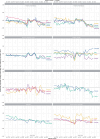Birth rate decline in the later phase of the COVID-19 pandemic: the role of policy interventions, vaccination programmes, and economic uncertainty
- PMID: 39345877
- PMCID: PMC11438547
- DOI: 10.1093/hropen/hoae052
Birth rate decline in the later phase of the COVID-19 pandemic: the role of policy interventions, vaccination programmes, and economic uncertainty
Abstract
Study question: What are the factors influencing the decline in the birth rates observed in higher-income countries in the later phase of the COVID-19 pandemic?
Summary answer: Our results suggest that economic uncertainty, non-pharmaceutical policy interventions, and the first wave of the population-wide vaccination campaign were associated with the decline in birth rates during 2022.
What is known already: During the COVID-19 pandemic, birth rates in most higher-income countries first briefly declined and then shortly recovered, showing no common trends afterwards until early 2022, when they unexpectedly dropped.
Study design size duration: This study uses population-wide data on monthly total fertility rates (TFRs) adjusted for seasonality and calendar effects provided in the Human Fertility Database (HFD). Births taking place between November 2020 and October 2022 correspond to conceptions occurring between February 2020 and January 2022, i.e. after the onset of the pandemic but prior to the Russian invasion of Ukraine. The data cover 26 countries, including 21 countries in Europe, the USA, Canada, Israel, Japan, and the Republic of Korea.
Participants/materials setting methods: First, we provided a descriptive analysis of the monthly changes in the TFR. Second, we employed linear fixed effects regression models to estimate the association of explanatory factors with the observed seasonally adjusted TFRs. Our analysis considered three broader sets of explanatory factors: economic uncertainty, policy interventions restricting mobility and social activities outside the home, and the progression of vaccination programmes.
Main results and the role of chance: We found that birth trends during the COVID-19 pandemic were associated with economic uncertainty, as measured by increased inflation (P < 0.001), whereas unemployment did not show any link to births during the pandemic (P = 0.677). The stringency of pandemic policy interventions was linked to a postponement of births, but only in countries with lower institutional trust and only in the early phase of the pandemic (P = 0.003). In countries with higher trust, stricter containment measures were positively associated with birth rates, both for conceptions in the first year of the pandemic (P = 0.019) and, albeit only weakly significant, for conceptions later in the pandemic (P = 0.057). Furthermore, we found a negative association between the share of the population having received the first dose of the COVID-19 vaccination and TFRs (P < 0.001), whereas the share of the population having completed the primary vaccination course (usually consisting of two doses) was linked to a recovery of birth rates (P < 0.001).
Large scale data: N/A.
Limitations reasons for caution: Our research is restricted to higher-income countries with relatively strong social support policies provided by the government as well as wide access to modern contraception. Our data did not allow analyses of birth trends by key characteristics, such as age, birth order, and social status.
Wider implications of the findings: This is the first multi-country study of the drivers of birth trends in the later phase of the COVID-19 pandemic. In the past, periods following epidemics and health crises were typically associated with a recovery in births. In contrast, our results show that the gradual phasing out of pandemic containment measures, allowing increased mobility and a return to more normal work and social life, contributed to declining birth rates in some countries. In addition, our analysis indicates that some women avoided pregnancy until completion of the primary vaccination protocol.
Study funding/competing interests: This study did not use any external funding. The authors acknowledge funding from their home institution, the Vienna Institute of Demography of the Austrian Academy of Sciences, and from the Open-Access Fund of the Austrian Academy of Sciences. For the purpose of open access, the authors have applied a CC BY public copyright licence to any Author Accepted Manuscript versions arising from this submission. All authors declare that they have no conflicts of interest.
Keywords: COVID-19 pandemic; births; economic uncertainty; higher-income countries; inflation; policy responses; total fertility rate; unemployment rate; vaccination.
© The Author(s) 2024. Published by Oxford University Press on behalf of European Society of Human Reproduction and Embryology.
Conflict of interest statement
All authors declare that they have no conflicts of interest.
Figures





References
-
- Baker SR, Bloom N, Davis SJ.. Measuring economic policy uncertainty. Quart J Econ 2016;131:1593–1636.
-
- Bellani D, Vignoli D.. COVID-19 and relationship quality: emotional, paid work and organizational spheres. Vienna Yearbook of Population Research 2022;20:195–221.
-
- Berman Institute of Bioethics & Center for Immunization Research JHU. Covid-19 Maternal Immunization Tracker (COMIT). 2023. https://www.comitglobal.org/explore/public-health-authorities/pregnancy (31 October 2023, date last accessed).
-
- Berrington A, Ellison J, Kuang B, Vasireddy S, Kulu H.. Scenario-based fertility projections incorporating impacts of COVID-19. Popul Space Place 2022;28:e2546.
LinkOut - more resources
Full Text Sources
Medical
Research Materials
Miscellaneous
